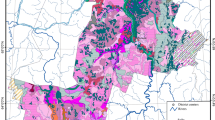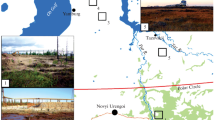Abstract
A site evaluation was made for a low-lying property in an old river levee/marsh association, used marginally for cattle raising, which was contaminated due to historical practices. Contamination was related to geomorphology: the lowest areas contained 79 % of the contaminated samples. Other contaminated samples were all rear access roads (probable intentional dumping). There were no samples in the higher, levee areas away from roads with hydrocarbon concentrations above 3,000 mg/kg. Medium and high impact levels, corresponding to average hydrocarbon concentrations of 13,400 mg/kg and 109,700 mg/kg, respectively, were found in 28 % and 27 % of the property area. The medium impact level was predicted to have a reduced pasture production potential of ∼ 50 % while at the high impact level practically no pasture production was predicted. Toxicological risk to cattle is present in only 12 % of the sample points although almost all of these are in very marshy areas not apt for cattle raising. Because the hydrocarbons at this tropical site are very weathered, acute toxicity was not related to hydrocarbon concentration. Although slightly more than half of the property has hydrocarbon concentrations above the permissible limit, only about one-third of the contaminated area is apt for cattle raising. This study, based on hydrocarbon distribution related to site geomorphology, soil toxicity bioassay, risk assessment to cattle and evaluation of pasture production allowed to made a more accurate assessment and definition of future use of the site. These criteria could be used for diagnostic studies of sites with similar tropical conditions.
Similar content being viewed by others
References
Adams Schroeder, R. H.; Domínguez Rodríguez, V. I.; García Hernández, L., (1999). Potencial de la biorremediación de suelo y agua impactado por petróleo en el trópico Mexicano. Terra., 17 (2), 159–174 (16 pages).
Adams, R. H., (2004). Chemical —biological stabilization method for treatment of drilling cuttings and hydrocarbon contaminated soil. 11th. International Environmental Petroleum Conference. International Environmental Petroleum Consortium. Albuquerque NM, USA. (http://ipec.utulsa.edu/Conf2004/Papers/adams.pdf)
Adams, R. H.; Morales-García, F., (2008a). Concentración residual de hidrocarburos en suelo del trópico: Parte I. - Consideraciones para la salud publica y protección al ganado. Interciencia, 33 (7), 476–482 (7 pages).
Adams, R. H.; Zavala Cruz, J.; Morales-García, F., (2008b). Concentración residual de hidrocarburos en suelo del trópico: Parte II. - Afectación a la fertilidad y su recuperación. Interciencia., 33 (7), 483–489 (7 pages).
Adams, R. H.; Guzmán-Osorio, F. J.; Zavala-Cruz, J., (2008c). Water repellency in oil contaminated sandy and clayey soils. Int. J. Environ. Sci. Tech., 5 (4), 445–454 (10 pages).
Beltrán, J. E., (1993). Los impactos del petróleo. In: Tabasco: Realidad y perspectivas. Gobierno del Estado de Tabasco. Villahermosa, Mexico, D.F.
Benka-Coker; M. O.; Ekundayo, J. A., (1995). Effects of an oil spill on soil physico-chemical properties of a spill site in the Niger delta area of Nigeria. Environ. Monit. Assess., 36 (2): 93–104 (12 pages).
Carvalho, F. P.; Villeneuve, J. P.; Cattini, C.; Tolosa, I.; Montenegro-Guillén, S.; Lacayo, M; Cruz, A., (2002). Ecologica l risk a ssessment of pesticide residues in coasta l lagoons of Nicaragua. J. Environ. Monit., 4 (5), 778–787 (10 pages).
Cram, S.; Siebe, C.; Ortíz-Salinas, R.; Herre, A., (2004). Mobility and Persistence of petroleum hydrocarbons in peat soils of southeastern Mexico. Soil Sed. Contaminat. 13 (5), 341–360 (20 pages).
Dakui, Z.; Yong, Y.; Martini, L. P., (2005). Geomorphology of the Boao coastal system and potential effects of human activities - Hainan Island, South China. J. Geogr. Sci., 15 (2), 187–198 (12 pages).
Díaz-Ramírez, I. J.; Gutiérrez-Rojas, M.; Ramírez-Saad, H.; Favela-Torres, E., (2003). Biodegradation of Maya crude oil fractions by bacterial strains and a defined mixed culture isolated from Cyperus laxus rhizosphere soil in a contaminated site. Can. J. Microbiol., 49 (12), 755–761 (7 pages).
Ekundayo, E. O.; Obuekwe, C. O., (1997). Effects of an oil spill on soil physico-chemical properties of a spill site in a typic paleudult of midwestern Nigeria. Environ. Monit. Assess., 45 (2), 209–221 (13 pages).
Feddema, J. J., (2005). A revised Thornthwaite-type global climate classification. Phys. Geogr., 26 (6), 442–466 (25 pages).
Gallegos-Martinez, M.; Gómez-Santos, A.; González-Cruz, L.; Montes de Oca-García, M. A.; Yáñez-Trujillo, L.; Zermeño-Eguía Lis, J.A.; Gutiérrez-Rojas, M., (2000). Diagnostic and resulting approaches to restore petroleum-contaminated soil in a Mexican tropical swamp. Water Sci. Tech., 42 (5-6), 377–384 (8 pages).
García-López, E.; Zavala-Cruz, J.; Palma-López, D. J., (2006). Caracterización de las comunidades vegetales en un área afectada por derrames de hidrocarburos. Terra Latinoamericana, 24 (1), 17–26 (10 pages).
Gobierno del Estado de Veracruz, (2005). Enciclopedia de los municipios de México, Estado de Veracruz de Ignacio de la Llave. Instituto Nacional para el Federalismo y el Desarrollo Municipal. Xalapa, Veracruz, México. http://www.e.local.gob.mx/work/templates/enciclo/veracruz/
Gustafson, J.; Griffith Tell, J.; Orem, D., (1997). Selection of representative TPH fractions based on fate and transport considerations. Total Petroleum Hydrocarbon Criteria Working Group Series, Vol. 3. The Association of Environmental Health and Sciences, Massachussettes, USA.
IAEA, (1994). Handbook of parameter values for the prediction of radionucleotide transfer in temperate environments. International Atomic Energy Agency. Technical Report Series No. 364. Vienna, Austria.
Iturbe, R.; Flores, R. M.; Flores, C. R.; Torres, L. G., (2004). TPH-contaminated Mexican refinery soil: health risk assessment and the first year of changes. Environ. Monit. Assess., 91 (1-3), 237–255 (19 pages).
Köppen, W., (1900). Versuch einer Klassifikation der Klimate, Vorzugsweise nach ihren Beziehungen zur Pflanzenwelt. Geog. Z., 6 (593-611), 657–679 (23 pages).
Luthy, R. G.; Aiken, G. R.; Brusseau, M. L.; Cunningham, S. D.; Gschwend, P. M.; Pignatello, J. J.; Reinhard. M.; Traina, S. J.; Weber, W. J.; Westall, J. C., (1997). Sequestration of hydrophobic organic contaminants by geosorbents. Environ. Sci. Tech., 31 (12), 3341–3347 (7 pages).
Okafor, E. Ch., Opuene, K., (2007). Preliminary assessment of trace metals and polycyclic aromatic hydrocarbons in the sediments. Int. J. Environ. Sci. Tech., 4 (2), 233–240 (8 pages).
Opuene, K.; Agbozu, I. E.; Ekeh, L. E., (2007). Identification of perylene in sediments: Occurrence and diagenetic evolution. Int. J. Environ. Sci. Tech., 4 (4), 457–462 (6 pages).
Osuji, L. C.; Opiah, U. C., (2007). Hydrocarbon contamination of a terrestrial ecosystem: The case of Oshire-2 oil spill in Niger Delta, Nigeria. Environmentalist., 27 (3), 337–340 (4 pages).
Pattanayek, M.; DeShields, B., (2003). Characterizing risks to livestock from petroleum hydrocarbons. 10th. Annual International Environmental Petroleum Conference, University of Tulsa/ Integrated Petroleum Environmental Consortium. http://ipec.utulsa.edu/Ipec/Conf>2003/Papers/pattanayek_deshields_29.pdf
Petrôleos Mexicanos., (1988). El Petróleo. Gerencia de Información y Relaciones Públicas, México, D.F.
Razo, I.; Diaz-Barriga, F.; Castro, J.; Marcos M., (2006). Environmental geochemistry studies and health risk assessment to identify priority areas for remediation of polluted soils in the Santa Maria de la Paz (S.L.P., Mexico) mining district. Chinese J. Geochem., 25 (Suppl.), 61.
Rivera-Cruz, M. C.; Tujillo-Narcía, A., (2004). Estudio de toxicidad vegetal en suelos con petróleos nuevo e intemperizado. Interciencia, 29 (7), 369–376 (8 pages).
SECOFI (1996). Norma Mexicana NMX-AA-112-1995-SCFI, Análisis de agua y sedimento — Evaluación de toxicidad aguda con Photobacterium phosphoreum. Secretaría de Comercio y Fomento Industrial. Método de prueba. Secretaria de Comercio y Fomento Industrial (SECOFI), Dirección General de Normas, México, D.F.
ARNAT (2004). Oficio No. DGGIMAR. 710/003255. Autorización para el tratamiento de residuos peligrosos. Secretaria de Medio Ambiente y Recursos Naturales. Autorización No. 30-108-GM-V-04-2004. No. de registro ambiental PREM00901611.
ARNAT (2005). Norma Oficial Mexicana NOM-138-SEMARNAT/SS-2003, Limites maximos permisibles de hidrocarburos en suelos y las especificaciones para su caracterización y remediación. Secretaria de Medio Ambiente y Recursos Naturales. Diario Oficial de la Federación, México, D.F.
Stober, V. M., (1962). Vetraglichkeitsprufungen Mit Roh-und Heizol an Rindern. Deutsche Tierarzliche Wochenschrift, 69, 386–390 (5 pages).
ias, B.; Mendoza, G. D.; Arjona, E.; García-Bojalil, C.; Suárez, M. E., (1997). A simulation model of performance of growing steers grazing in tropical pastures. J. Anim. Sci., 75 (Suppl. 1), 271.
Wang, Y.; Ding, X., (2000). Hydrocarbon alteration characteristics of soils and mechanism for detection by remote sensing in east Sichuan area, China. Nat. Resour. Res., 9 (4), 295–305 (11 pages).
Zach, R.; Mayoh, K. R., (1984). Soil ingestion by cattle: A neglected pathway. Health Phys., 46 (2), 426–430 (5 pages).
Zavala, C., J.; Gavi, R. F.; Adams, S. R. H.; Ferrera-Cerrato, R.; Palma-López, J. D.; Vaquera, H. H.; Domínguez, E. M., (2005). Derrames de petróleo en suelos y adaptación de pastos tropicales en el Activo Cinco Presidentes, Tabasco. Terra Latinoamerica, 23 (2), 293–302 (10 pages).
Author information
Authors and Affiliations
Corresponding author
Rights and permissions
About this article
Cite this article
Adams, R.H., Olán-Castro, D., Guzmán-Osorio, F.J. et al. Relationship between geomorphology and contamination with weathered hydrocarbons in an old river levee/marsh association. Int. J. Environ. Sci. Technol. 6, 527–538 (2009). https://doi.org/10.1007/BF03326092
Received:
Revised:
Accepted:
Published:
Issue Date:
DOI: https://doi.org/10.1007/BF03326092




